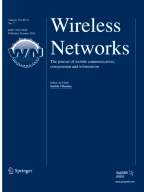Abstract
In IEEE 802.11, the rate of a station (STA) is dynamically determined by link adaptation. Low-rate STAs tend to hog more channel time than high-rate STAs due to fair characteristics of carrier sense multiple access/collision avoidance, leading to overall throughput degradation. It can be improved by limiting the transmission opportunities of low-rate STAs by backoff parameters. This, however, may cause unfair transmission opportunities to low-rate STAs. In an attempt to increase overall throughput by volunteer high-rate relay STAs while maintaining fairness, we propose a new cooperative medium access control (MAC) protocol, relay-volunteered multi-rate cooperative MAC (RM-CMAC) based on ready to send/clear to send in multi-rate IEEE 802.11. In the RM-CMAC protocol, we show that the effect of hogging channel time by low-rate STAs can be remedied by controlling the initial backoff window size of low-rate STAs and the reduced transmission opportunity of low-rate STAs can be compensated by the help of volunteer high-rate relay STAs. We analyze the performance of RM-CMAC, i.e., throughput and MAC delay, by a multi-rate embedded Markov chain model. We demonstrate that our analysis is accurate and the RM-CMAC protocol enhances the network throughput and MAC delay while maintaining the fairness of low-rate STAs.
Similar content being viewed by others
Notes
IEEE 802.11a/g/n can also be analyzed with our model and framework.
References
IEEE 802.11 (2007). Part 11: Wireless LAN medium access control (MAC) and physical layer (PHY) specifications. New York: IEEE Societies.
Gast, M. S. (2002). 802.11 wireless networks: The definitive guide. Sebastopol, CA: OReilly& Associates.
Heusse, M., Rousseau, F., Sabbatel, G. B., Duda, A. (2003). Performance anomaly of 802.11b. In Proceedings of IEEE INFOCOM’2003, San Francisco, California, USA.
Yang, D.-Y., Lee, T.-J., Jang, K., Chang, J.-B., Choi, S. (2006). Performance enhancement of multirate IEEE 802.11 WLANs with geographically scattered stations. IEEE Transactions on Mobile Computing, 5 (7), 906–919.
Kim, H., Yun, S., Kang, I., Bahk, S. (2005). Resolving 802.11 performance anomalies through QoS differentiation. IEEE Communications Letters, 9(7), 655–657.
Xiao, Y. (2003). Backoff-based priority schemes for IEEE 802.11. In Proceedings of IEEE ICC’2003, Anchorage, Alaska, USA.
Holland, G., Vaidya, N., Bahl, P. (2001). A rate-adaptive MAC protocol for multi-hop wireless networks. In Proceedings of ACM MOBICOM’2001, Rome, Italy.
Sadeghi, B., Kanodia, V., Sabharwal, A., Knightly, E. (2002). Opportunistic media access for multirate ad hoc networks. In Proceedings of ACM MOBICOM’2002, Atlanta, Georgia, USA.
Medepalli, K., Tobagi, F. A. (2006). On optimization of CSMA/CA based wireless LANs: Part I - impact of exponential backoff. In Proceedings of IEEE ICC’2006, Istanbul, Turkey.
Haratcherev, I. (2006). Application-oriented link adaptation for IEEE 802.11. Ph.D Dissertation, Delft University of Technology.
Liu, P., Tao, Z., Lin, Z., Erkip, E., Panwar, S. (2006). Cooperative wireless communications : A cross-layer approach. IEEE Wireless Communications Magazines, 13(4), 84–92.
Nosratinia, A., Hunter, T. E., Hedayat, A. (2004). Cooperative communication in wireless networks. IEEE Communications Magazine, 42(10), 74–80.
Liu, P., Tao, Z., Narayanan, S., Korakis, T., Panwar, S. S. (2007). CoopMAC: A cooperative MAC for wireless LANs. IEEE Journal on Selected Areas in Communications, 25(2), 340–354.
Shankar N. S., Chou, C.-T., Ghosh, M. (2005). Cooperative communication MAC (CMAC)—A new MAC protocol for next generation wireless LANs. In Proceedins of IEEE WiCOM’2005, Maui, Hawaii, USA.
Liu, Y., Liu, K., Zeng, F. (2011). A relay-contention-free cooperative MAC protocol for wireless networks. In Proceedings of IEEE CCNC’2011, Las Vegas, Nevada, USA.
Kim, J.-S., Lee, T.-J. (2009). Performance enhancement of IEEE 802.11b WLANs using cooperative MAC protocol. Springer-Lecture Notes in Computer Science, 5593, 335–344.
Bianchi, G. (2002). Performance analysis of the IEEE 802.11 distributed coordination function. IEEE Journal on Selected Areas in Communications, 18(3), 535–547.
Yun, L., Ke-Ping, L., Wei-Liang, Z., Chong-Gang, W. (2005). Analyzing the channel access delay of IEEE 802.11 DCF. In Proceedings of IEEE GLOBECOM’2005, Saint Louis.
Chatzimisios, P., Boucouvalas, A. C., Vitsas, V. (2003). Packet delay analysis of IEEE 802.11 MAC protocol. Electronics Lettes, 39(18), 1358–1359.
Park, E.-C., Kim, D.-Y., Choi, C.-H., So, J. (2007). Improving quality of service and assuring fairness in WLAN access networks. IEEE Transactions on Mobile Computing, 6(4), 337–350.
Kuo, Y.-L., Lai, K.-W., Lin, F.Y.-S., Wen, Y.-F., Wu, E.H.-K., Chen, G.-H. (2009). Multirate throughput optimization with fairness constraints in wireless local area networks. IEEE Transactions on Vehicular Technology, 5(5), 2417–2425.
Joshi, T., Mukherjee, A., Yoo, Y., Agrawal, D.P. (2008). Airtime fairness for IEEE 802.11 multirate networks. IEEE Transactions on Mobile Computing, 7(4), 513–527.
Wu, X. (2004). Simulate 802.11b channel within NS2. Technical Report. National University of Singapore. http://cir.nus.edu.sg/reactivetcp/report/80211ChannelinNS2_new.pdf.Accessed10Jan.2012.
Acknowledgments
This work was supported by Priority Research Centers Program through the National Research Foundation of Korea(NRF) funded by the Ministry of Education, Science and Technology (2011-0018397), and the MKE (The Ministry of Knowledge Economy), Korea, under the ITRC (Information Technology Research Center) support program supervised by the NIPA (National IT Industry Promotion Agency) (NIPA-2011-(C1090-1111-0005)).
Author information
Authors and Affiliations
Corresponding author
Rights and permissions
About this article
Cite this article
Kim, JS., Oh, CY. & Lee, TJ. Relay-volunteered multi-rate cooperative MAC protocol for IEEE 802.11 WLANs. Wireless Netw 19, 1945–1960 (2013). https://doi.org/10.1007/s11276-013-0576-y
Published:
Issue Date:
DOI: https://doi.org/10.1007/s11276-013-0576-y
